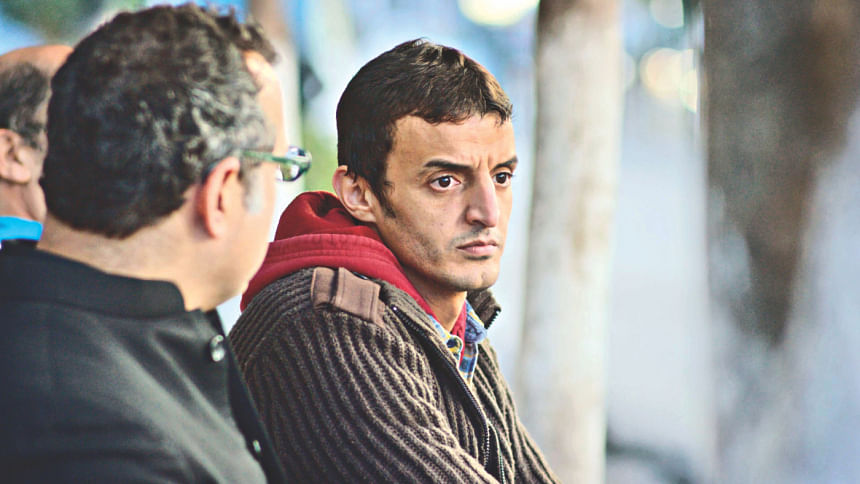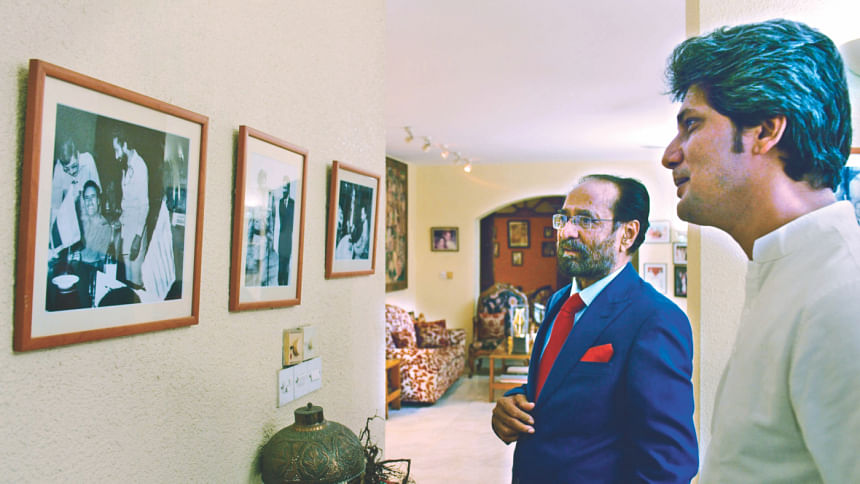Two Meetings and a Funeral

“This movie is basically a war against forgetting,” explains one of the main protagonists at the end of Two Meetings and a Funeral, Naeem Mohaiemen’s mesmerising three-channel film about political ideals, the gigantic state architecture built to house them, and the Non-Aligned Movement.
The what, you might ask? Or at least I did, not having ever heard of NAM before. That is a shortcoming of my own education in international politics, but it is also a consequence of the fact that the movement lost the very real potential it had in the 1960s and early 1970s to shake up the world for the better, to create a planetary politics not dominated by the Euro-American powers, to promote socialism, sovereignty, and decolonisation. That’s at least part of the case made by Two Meetings and a Funeral (2017), which among other themes examines a pivotal moment in the mid-1970s when a second movement, the Saudi-led Organisation of Islamic Cooperation, convinced enough of the Third World countries allied as NAM to choose Islamism over socialism as their unifying ideology. I won’t attempt to summarise the political history lesson much more than that because the film isn’t really trying to be one. Indeed, not until I looked NAM up on Wikipedia in order to clarify a few details did I realise that the movement continues to operate today. The titular funeral marks NAM’s transformation into a coalition that no longer mattered, not one that technically ceased to exist.
Mohaiemen’s 88-minute film—one of a handful of timely, striking artworks included in documenta 14—provides a humbling and maddening reminder of the complications of politics. Good intentions are never enough; singularity of purpose is nearly impossible to achieve; the what ifs are legion. The world just keeps on turning, entanglements and controversies and madness and assassinations piling endlessly on. (Some of the figures who appear in the film’s archival footage as members of NAM include a dashingly clean-shaven Muammar Gaddafi, a serious and composed Indira Gandhi, and a swaggering Yasser Arafat in dark shades.) It goes without saying that the US does not figure well, with CIA-backed coups hovering just off-stage everywhere, undermining socialist governments and siding with new military regimes. In a speech met with big applause, a Vietnamese delegate trumpets Cuba’s demand that the US withdraw from Guantanamo. If only.
Though these are some of the dominant political themes of Two Meetings and a Funeral, they don’t explain its cinematic impact, which for me arises out of structural problems. How to reconstruct a movement relegated to the dustbin of history? How to suggest its relevance for today? How to do this artfully, playfully, with serious depth but no didacticism? What can it look like and sound like? Mohaiemen’s solutions to these quandaries make of his film something not quite documentary but definitely not fiction, full of tangents and footnotes and unexpected connections and poetic pauses. It feels utterly contemporary, and it sounds it too, thanks to an unusual film score by Qasim Naqvi, who used a collection of analog synthesisers to create a soundscape of horror-movie tones at once space-age and foreboding.
The film stretches across three screens, which leaves plenty of room for crisp translations of conversations being had in French or Arabic or Bangla, tersely informative captions about pertinent world events, but also lyrical subtitles like “Fear of a Red Planet” and “Season of Tigers”—as if global history had all the drama of fiction, which actually it does. Often the screens fill simultaneously with multiple views of individual people, events and places, insisting that there is always another perspective, an edit, a cut, an outside the frame. This may be de rigueur in contemporary filmmaking, but it seems rather remarkable given how much of the film’s raw material comes from the Algerian National TV archives, which were mined for historical visuals of the titular two meetings (one of NAM, one of OIC). While much of that footage is straightforward speechmaking, some of the best of it is audience reaction (or non-reaction) and casual inter-delegate camaraderie. Yes, it is fun to watch world leaders in their off moments, giggling and nudging one another, or just staring off into space.

And to note who does and doesn’t have their simultaneous-translation headphones on when someone else is up at the podium. Revelations come from the margins.
Not all the footage is archival, however, and that’s where Mohaiemen and his various protagonists succeed in spinning off the most unexpected and potent minor stories. The settings for these spinoffs are often grand modernist structures, the kind built transcontinentally from the 1950s onward, big bold buildings created to house big bold ideas. These have not, on the whole, aged well. Oscar Niemeyer’s La Coupole, a sports stadium-cum-spaceship in Algiers, is badly in need of rust-proofing and fresh paint. Le Corbusier’s General Assembly Hall of the UN looks to be technologically and stylistically stuck in a previous era. A conference center built in Dhaka for a 1990 NAM summit, infinitely postponed, was finally opened under the name China Friendship Center, then later renamed Bangabandhu Center after the assassinated president Sheikh Mujibur Rahman. Today it can also be booked for private events and trade fairs. The camera has a great time getting up close and personal with these architectural situations.
And then there are the little stories themselves: In New York, the Marxist historian Vijay Prashad spends time in the old card catalogues at the United Nations, pulling out now-empty drawers and musing on the ways that research has changed in the digital age, eliminating those accidental finds that came from the way information used to be physically organized. He pauses, too, to stare at a shiny model of Sputnik suspended in the lobby, then gets to thinking about how the Space Race and Spelling Bees and his late friend, a radio broadcaster named Sputnik Kilambi, are all connected. In Algiers, Prashad walks the city streets and the halls of the Palais des Nations with the archaeologist-publisher Samia Zennadi, who tells a story about Madame Nguyen Thi Binh, a minister in the Revolutionary Government of South Vietnam who came to Algiers as a delegate for the 1973 NAM meeting and, instead of dining with the other heads of state, sought out and ate with the cooks. In Dhaka, the leftist politician and one-time mayoral candidate Zonayed Saki visits the well-appointed home of Amirul Islam, a former government official of newly independent Bangladesh. Islam recalls being given prayer beads at the NAM summit by an Arab leader, who told him to return them when they saw each other next—foreshadowing the OIC meeting to come, where Bangladesh would be caught in the middle of the two competing movements. Islam’s photographs of those events are measured and rehung on the walls of his apartment, as if somehow their repositioning will get history right. It’s a futile task: the frames remain hopelessly crooked.
Lori Waxman has been the Chicago Tribune’s primary freelance art critic for the past decade. She is a senior lecturer at the School of the Art Institute of Chicago and has a Ph.D. in art history from the Institute of Fine Arts in New York.

 For all latest news, follow The Daily Star's Google News channel.
For all latest news, follow The Daily Star's Google News channel. 



Comments